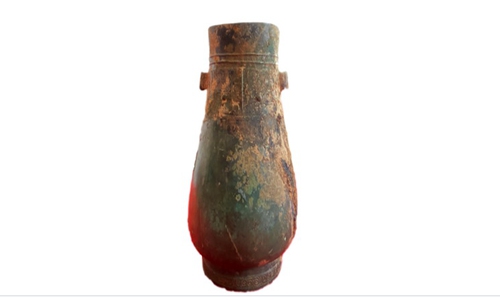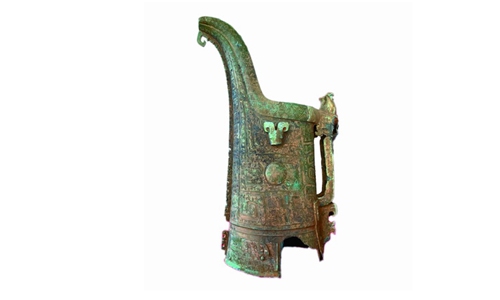Two 3,000-year-old bronze wares unearthed by villagers in Central China’s Hunan Province
Two bronze wares made more than 3,000 years ago were recently unearthed in Central China's Hunan Province, the Hunan Institute of Cultural Relics and Archaeology announced on Thursday. It is believed that the bronzes were sacrificial vessels used during religious ceremonies.
According to the Thursday announcement, a rare bronze wine vessel weighing 13.45 kilograms and a bronze pot weighing 2.25 kilograms dating back to the Shang Dynasty (1600-1046BC) were discovered as villagers in Miluo, Hunan Province were digging for a road construction project.


Archaeologists said that the discovery will enrich the understanding of bronze culture in the Yangtze River basin in southern China, and be an important reference for the study of ancient Chinese bronze civilization.
"Two bronzes were unearthed on the top of a hill named Yemaozui [Lit: wild cat mouth] at an altitude of about 80 meters and a distance of about 2.3 kilometers from the Miluo River [part of the water system of the Yangtze River]," introduced Sheng Wei, a research fellow at the institute.
Over the years, a large number of bronze wares have been found on the banks of rivers or on the slopes and mountaintops near rivers in the province.
Since no other remains such as bodies or clothes have been found along with these bronze objects, archaeologists surmise that they were not burial bronzes but rather ceremonial bronzes used during the religious rites of the time, noted Sheng, "and so are those two bronze wares, which had a similar use."
Due to the construction activities, the two bronzes were damaged after being unearthed. Additionally, the surface of the bronzes is partially obscured due to severe corrosion from? being buried for so long.
The institution said that restoration work is underway and that more information about the two bronzes will be published once the work is done.
Netizens were fascinated by these old objects, expressing the hopes that someday they will be able to see them on display in a local museum.
Yet among the many museums in China, the Palace Museum in Beijing has the largest collection of bronzes with about 10,000 bronzes, according to Beijing Evening News.
Hunan is famous for the large number of Shang and Zhou dynasties (1046-256BC) bronze wares that have been found there.
Discovered in April 1938, the Four Sheep Fangzun, or Fangzun of the Four Rams, is another ancient Chinese ritual bronze vessel unearthed in Changsha, Hunan Province. It is the largest known bronze in China and is believed to have been used in sacrificial rites during the late Shang Dynasty.
Global Times
According to the Thursday announcement, a rare bronze wine vessel weighing 13.45 kilograms and a bronze pot weighing 2.25 kilograms dating back to the Shang Dynasty (1600-1046BC) were discovered as villagers in Miluo, Hunan Province were digging for a road construction project.

A bronze pot weighing 2.25 kilograms dating back to the Shang Dynasty (1600-1046BC) were discovered as villagers in Miluo, Central China's Hunan Province was digging for a road construction project in November, 2021.

A rare bronze wine vessel weighing 13.45 kilograms dating back to the Shang Dynasty (1600-1046BC) were discovered as villagers in Miluo, Central China's Hunan Province was digging for a road construction project in November, 2021.
Archaeologists said that the discovery will enrich the understanding of bronze culture in the Yangtze River basin in southern China, and be an important reference for the study of ancient Chinese bronze civilization.
"Two bronzes were unearthed on the top of a hill named Yemaozui [Lit: wild cat mouth] at an altitude of about 80 meters and a distance of about 2.3 kilometers from the Miluo River [part of the water system of the Yangtze River]," introduced Sheng Wei, a research fellow at the institute.
Over the years, a large number of bronze wares have been found on the banks of rivers or on the slopes and mountaintops near rivers in the province.
Since no other remains such as bodies or clothes have been found along with these bronze objects, archaeologists surmise that they were not burial bronzes but rather ceremonial bronzes used during the religious rites of the time, noted Sheng, "and so are those two bronze wares, which had a similar use."
Due to the construction activities, the two bronzes were damaged after being unearthed. Additionally, the surface of the bronzes is partially obscured due to severe corrosion from? being buried for so long.
The institution said that restoration work is underway and that more information about the two bronzes will be published once the work is done.
Netizens were fascinated by these old objects, expressing the hopes that someday they will be able to see them on display in a local museum.
Yet among the many museums in China, the Palace Museum in Beijing has the largest collection of bronzes with about 10,000 bronzes, according to Beijing Evening News.
Hunan is famous for the large number of Shang and Zhou dynasties (1046-256BC) bronze wares that have been found there.
Discovered in April 1938, the Four Sheep Fangzun, or Fangzun of the Four Rams, is another ancient Chinese ritual bronze vessel unearthed in Changsha, Hunan Province. It is the largest known bronze in China and is believed to have been used in sacrificial rites during the late Shang Dynasty.
Global Times
